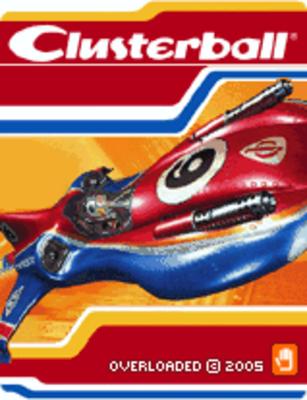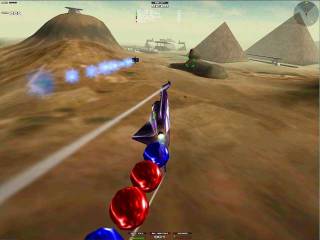Overview

In Clusterball it is the job of players to fly around the arena and find balls. Flying into these balls will add them to the tail behind their aircraft and flying through the ring in the enter of the arena will "score" them or their team. However, the longer the tail on an aircraft the heavier and slower they become, and the larger a target they make for enemies. Power-ups and weaponry appear around the arenas which when collected allow players to impede their opponents. The game features 14 total arenas and features both team-based and free-for-all modes.
The game was designed to be an e-sports game in a time where most people was connected with a dial up connection. This put very high demands on a forgiving network code. During development there was a lot of work put into the predictiveness of the code and in the end the game was playable with up towards 800 milliseconds of delay.
Equipment in the game
All equipment in the game was collected by special pickups around the venue. There where two different pickups: low poles around the arena where a single item of equipment was randomly placed and small and tight buildings through which the player flew to collect equipment. Below is a list of the items.
Ballsnatcher
A guided missile that when it hit an opponent stole all balls collected and returned them to the player. A speciality was firing a ballsnatcher through the scoring ring at an opponent with balls and having the Ballsnatcher return them through the ring, thus getting a snatcher-score which was awarded double points.
Smoke Puffs
An aimed weapon that shot off the balls of an opponent and slightly nudged his aircraft a bit.
Shock Wave
An explosion the player send out behind the aircraft sending opponents following them tumbling uncontrollably.
Inverse Control
A guided missile that when it hit reversed the players opponents control scheme for about 10 seconds.
Backdraft
A guided missile that when it hit sent the player opponents flying backwards at insane speed.
Spaghetti String
An aimed weapon that stuck the opponent to the ground or an object with a rubber band effect
Gravity
A guided missile that when it hit put a gravity blob on the opponent that made the aircraft very difficult to fly.
Tractor Beam
An aimed weapon in which the player could trap an opponent and start smashing him/her into an object or the ground making him loose all his balls. The player could also score the opponents collected balls by tractoring him through the ring, which was called a "Tractor Score".
Other items
A few other items was in important for the game. These are listed below.
Radar
The player had a radar screen that overlooked the emidiate area around his ship to see where everyone flew and if someone was trying to sneak up behind to steal all the balls.
Radar beep
A warning signal that started beeping much like in the Alien movies and games. The beeps got more intense the closer the missile got.
Balls
The item that the player collected to score for points. There where three colours of the balls, red green and blue. Each of these colours gave a different amount of points when scored through the ring.
Scoring Ring
In the middle of an arena placed on the venue was a big scoring ring. This was the place where the player scored the balls they had collected on a string behind their aircraft. This was also the place where they where most likely to loose all the balls on their string to enemy fire or ball snatchers.
Start Plate/Hangar
The game was started on a small start plate situated close to the ring. This was also where the players re-spawned after crashing.
Venues
 An action screen cap from Egypt
An action screen cap from EgyptThe game was at first released with two free to play venues. A player could register and play these two venues for free and never have to pay for the game. Venue packs was later released, each pack had 3 new venues to play.
There was a couple of versions of the game released through its life cycle. But the first version had two free-to-play venues in it.
Bundled Venues | |
Venue Pack 1 - Metropolactica
- Taj Mahal
- Antarctica
| Venue Pack 2 |
Venue Pack 3 - Easter Island
- Yuccatan
- China
| Venue Pack 4 |
A Game Before Its Time
Clusterball had a very interesting number of feature and business models that actually took 6-7 years for the rest of the world to develop.
- Free to play.
- Ad supported revenue stream
- Online Only
- World Ranking
- Online Sales and Distribution
- Downloadable Content
The game was first meant to release for Macintosh computers only but was soon converted to the windows world of gaming because of the larger market size.
Free to play:
The game was supposed to be released with a free to play model with an ad-supported revenue stream. This was partly abandoned close to the release in favor of a free-to-play model with added DLC-plan.
In Game Advertising
Since players had to register to play the game the backend was able to deliver ads fitting each gamer individually. The ads was supposed to be displayed in game on big billboards spread around the landscape the players was flying over.
DLC
The game was released with two free venues/arenas to play for free and then an added pack of venues to buy. Later two more packs was released.
Online Only
The game was first supposed to be online only but when the release came closer and the long development period of the game had racked up quite an investment the online only model was abandoned for a mixed model of distribution. Distributors wanted single play to even consider it for distribution and a single player mode was added. AI for the game was not ready for action when the game was finally released.
Online Only Sales and Distribution
At first, when the game was supposed to be free but with in game advertising, the distribution was supposed to be online only. This was at the age where the average internet connection was a phone modem with 14000 baud (1.4 Kb/s). The game was because of this developed into a 14MB big game with the game code and two venues in it. Added venues was put in two packs that where supposed to be able to download separately. The cold feet of the Daydream management later changed this to a mixed model distribution of both boxed and online.
World Ranking
The game was built with competitiveness in mind and because of this a world ranking system was incorporated into the system. This was displayed both in game and on the web.
Had the game been released as originally intended it would have been an candidate for being the first game that did all this and perhaps would have started the Free-To-Play many years earlier.
Problems at Release
The game was not a commercial success which mainly could be attributed to the blended sales model that was chosen at the last moment of release. We now now that the Free-To-Play model has been a successful model to use for commercialization of a game but at this point it was an unknown and untested model. The model at this point had a few barriers to straddle before being successful.
The relative wariness of using a credit card online
At the time of release the common internet user was wary about using their credit/debit cards on the internet.
The information problem
Most of the information of computer games was spread via paper magazines This meant that that the word of a game took months to be spread and the critical mass of players needed to get momentum was never reached
Connection speeds
Even though the game was very small and made for high latency gaming most people never even tried to play because of their bad internet connection. They had already tested other action games and dismissed the possibility for other games to work.
Log in to comment